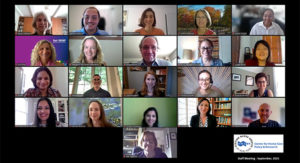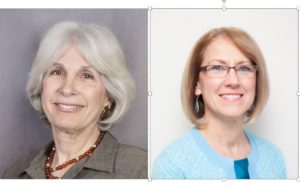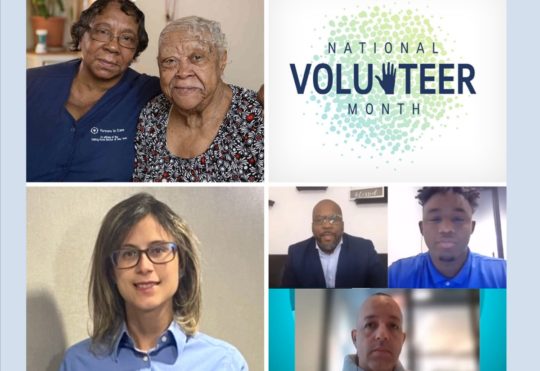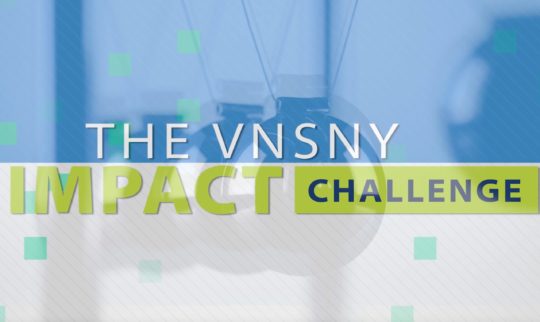12 Things You May Be Surprised to Know About the VNSNY Research Center
This article is part of an ongoing series in which Frontline will be highlighting different lines of business, programs, departments and teams across the organization. Our aim with this series is to enhance the VNSNY employee experience by spotlighting all parts of VNSNY, revealing things you may not know, and bringing our staff closer together. If you know of a VNSNY department or group that you think should be included in this series, please let us know by clicking here!
 The VNSNY Center for Home Care Policy & Research—or the VNSNY Research Center, for short—conducts objective research that advances the delivery of high-quality, cost-effective care in the home and community. The Center’s work informs home and community-based policy and clinical practice not only at VNSNY, but also nationally and even internationally.
The VNSNY Center for Home Care Policy & Research—or the VNSNY Research Center, for short—conducts objective research that advances the delivery of high-quality, cost-effective care in the home and community. The Center’s work informs home and community-based policy and clinical practice not only at VNSNY, but also nationally and even internationally.
Information on current studies and published articles published by the Center can be accessed by clicking here.
Here are 12 things you may not know about the VNSNY Research Center:
1. It is the only U.S. research institution housed within a home care organization. The Center for Home Care Policy & Research was founded in 1993 – the same year VNSNY celebrated its centennial. The center’s unique position as a part of VNSNY lets it draw on the valuable patient and member data gathered by VNSNY’s clinicians, and also allows its researchers to work with VNSNY’s operational staff to test the impact of new approaches and methods in the field.
2. The Center’s research projects fall into three focus areas:
-
- Improving the quality, cost-effectiveness, and outcomes of home and community-based services
- Analyzing and informing public policies that affect home-based care
- Supporting communities that promote successful aging in place
3. The Research Center is primarily funded through grants, some of which are in the millions of dollars. Main funders are the National Institutes of Health (which awarded the Center two multi-million-dollar grants in the past few months) and the Agency for Healthcare Research and Quality. Several foundations also support their work, most recently the Fan Fox & Leslie R Samuels Foundation and the Altman Foundation.
 4. Research Center staff have a variety of degrees and professional disciplines. The core staff is made up of 8 full-time and 9 part-time professionals, including six research scientists with PhDs. The Center also has 14 people engaged in per diem work for project-specific activities. Members of this multi-disciplinary team have backgrounds in nursing, public health, sociology, social work, psychology, political science, biostatistics, and engineering. Some staff also have joint appointments with Columbia University School of Nursing or University of Pennsylvania School of Nursing.
4. Research Center staff have a variety of degrees and professional disciplines. The core staff is made up of 8 full-time and 9 part-time professionals, including six research scientists with PhDs. The Center also has 14 people engaged in per diem work for project-specific activities. Members of this multi-disciplinary team have backgrounds in nursing, public health, sociology, social work, psychology, political science, biostatistics, and engineering. Some staff also have joint appointments with Columbia University School of Nursing or University of Pennsylvania School of Nursing.
5. The Center is also known for its outstanding directors. Its first director, Penny Feldman, who helped establish the VNSNY Research Center and headed it for 20 years, is famous for pioneering the use of data analytics and quality measures in home health care. In 2019, the Home Care Association of New York recognized Penny’s ground-breaking work by presenting her with its highest honor, the Ruth F. Wilson Award. The Center’s current director, Dr. Kathryn Bowles, has also had a distinguished career. A professor of the School of Nursing at the University of Pennsylvania, where she holds the vanAmeringen Chair of Nursing Excellence, Kathy has served on many national committees and workgroups and is a member of the International Nursing Research Hall of Fame.
6. People throughout VNSNY contribute to Research Center studies. To name a few current examples, nurses and physical therapists in the CHHA are now completing care transition surveys, home health aides are participating in interviews discussing their experiences during COVID-19, schedulers and intake staff are helping to develop a new intervention to improve timing of first visits for high-risk patients, and VNSNY Hospice is working with investigators to reduce disparities and improve outcomes of patients with advanced dementia.
7. It takes a village. In addition to the specific contributions noted in the previous entry, the involvement of clinicians, staff and leadership across the organization in our research efforts is vital to achieving the enterprise mission to improve the health and well-being of people through high quality, cost-effective health care in the home and community. Accurate input into the electronic health record, volunteering for qualitative interviews, and assisting in study implementation are all ways that VNSNY staff contribute to new knowledge and move VNSNY forward as a learning health system.
8. Collaboration with academic centers is common. Active collaborators include Columbia University, Weill Cornell Medicine, Mount Sinai School of Medicine, Johns Hopkins, University of Pennsylvania, and Villanova University.
9 Twenty-seven different Research Center studies were active in 2021. These range from small initiatives to participation in large multi-site studies.
10. The Research Center’s findings are shared through numerous peer-reviewed publications and presentations. So far in 2021, 21 scientific articles have been published in peer-reviewed journals. Over 360 articles and policy briefs have been published by Center staff since its founding.
![]() 11. A recent Research Center study found that patients with COVID-19 had a substantial improvement after being cared for in a Certified Home Health Agency (CHHA). The study findings were published in the Annals of Internal Medicine, the most-cited general internal medicine journal. The full study can be accessed by clicking here.
11. A recent Research Center study found that patients with COVID-19 had a substantial improvement after being cared for in a Certified Home Health Agency (CHHA). The study findings were published in the Annals of Internal Medicine, the most-cited general internal medicine journal. The full study can be accessed by clicking here.
12. Research Center staff members can be pretty competitive. During past holiday parties, an intense gingerbread house contest has fueled their competitive spirit. The Research Center staff, along with their friends in Business Intelligence and Analytics, look forward to resuming this tradition when it is safe to do so.
To read similar articles in the series on other teams in the organization, click here.

